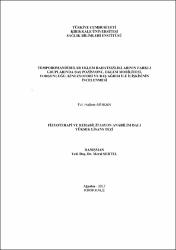| dc.contributor.advisor | Sertel, Meral | |
| dc.contributor.author | Arıkan, Halime | |
| dc.date.accessioned | 2021-01-16T19:03:57Z | |
| dc.date.available | 2021-01-16T19:03:57Z | |
| dc.date.issued | 2017 | |
| dc.identifier.uri | | |
| dc.identifier.uri | https://hdl.handle.net/20.500.12587/15907 | |
| dc.description | YÖK Tez ID: 474519 | en_US |
| dc.description.abstract | Bu çalışma, Temporomandibular Eklem Rahatsızlıkları/Araştırma Teşhis Kriterleri (TMER/ATK)'ne göre farklı gruplara ayrılan bireylerde baş pozisyonu, eklem mobilitesi, yorgunluğu, kinezyofobi ve baş ağrısı arasındaki ilişkiyi incelemek amacıyla planlandı. Çalışmaya toplam 77 TMER tanılı birey dahil edildi. Bireyler TMER/ATK'ye göre grup 1; kas rahatsızlığı olan (n=25), grup 2; disk deplasmanı olan (n=27), grup 3; diğer eklem rahatsızlıkları olan bireyler (n=25) olmak üzere 3 gruba ayrıldı. Bireylerin sosyodemografik bilgileri alındıktan sonra, baş pozisyonu gonyometre ile, eklem mobilitesi cetvel ile ölçüldü; eklem yorgunluğu sakız çiğneme testi ile, kinezyofobi Tampa Kinezyofobi Ölçeği (TKÖ) ile, baş ağrısı Baş Ağrısı Etki Testi (HIT-6) ile ve boyun fonksiyonelliği ise Kopenhag Boyun Fonksiyonel Özürlülük Skalası (KBFÖS) ile değerlendirildi. Gruplar arası yapılan istatistiksel analizde; baş pozisyonu, eklem mobilitesi, yorgunluğu ve baş ağrısı açısından fark bulunmazken (p>0.05), grup 3'teki bireylerin TKÖ değerleri diğer TMER'li bireylerden daha yüksek bulundu (p<0.05). TMER'li bireylerde yapılan korelasyon analizinde; tüm bireylerde servikal mobilite ile baş pozisyonu, eklem yorgunluğu, kinezyofobi ve baş ağrısı; eklem yorgunluğu ile baş ağrısı; kinezyofobi ile eklem mobilitesi arasında ilişki saptandı. Grup 1'de eklem yorgunluğu ile kinezyofobi; grup 2'de eklem yorgunluğu ile baş pozisyonu ve kinezyofobi arasında bir ilişki olduğu gözlendi; grup 3'te kinezyofobi ile yaş arasında bir ilişki bulundu (p<0.05). TMER'li bireylerde baş pozisyonu, eklem mobilitesi ve servikal mobilite etkilenmekte; eklem yorgunluğu, kinezyofobi ve baş ağrısı görülebilmektedir. Birçok faktörle ilişkili TMER'de, ayrıntılı bir değerlendirme ile birlikte, tedavi yöntemleri kapsamlı ve multidisipliner olmalıdır. | en_US |
| dc.description.abstract | This study was planned to investigate the relation between head position, mobility and fatigue of joint, kinesiophobia and headache in individuals whom were seperated into different groups according to the Research Diagnostic Criteria for Temporomandibular Disorders (TMD/RDC). A total of 77 subjects with TMD participated to the study. Individuals were divided into 3 groups according to the TMD/RDC: Group 1; muscle disorders (n=25), group 2; disc displacement (n=27), group 3; other joint diseases (n=25). After getting sociodemographic information of individuals; head position with goniometer, joint mobility with ruler were measured; joint fatigue with chewing gum test, kinesiophobia with Tampa Scale for Kinesiophobia (TSK), headache with Headache Impact Test (HIT-6) and neck functionality with Kopenhag Neck Functional Disability Scale (KNFDS) were assessed. In statistical analysis among groups; TSK values of individuals in group 3 were higher than the other with TMD (p<0.05); while in terms of head position, joint mobility, fatigue and headache weren't differ (p>0.05). In the correlation analysis of individuals with TMD; it was determined correlation among head position, joint fatigue, kinesiophobia and headache with cervical mobility; between joint fatigue and headache in all of the subjects. In group 1, it was determined correlation between joint fatigue and kinesiophobia; in group 2, it observed that be in a relation among head position and kinesiophobia with joint fatigue; in group 3, it was found the correlation between kinesiophobia and age (p<0.05). Head position, joint mobility and cervical mobility are affected; and joint fatigue, kinesophobia and headache can be observed in individuals with TMD. Together with a detailed assessment; treatment methods must be comprehensive and multidisciplinary in TMD associated with many factors. | en_US |
| dc.language.iso | tur | en_US |
| dc.publisher | Kırıkkale Üniversitesi | en_US |
| dc.rights | info:eu-repo/semantics/openAccess | en_US |
| dc.subject | Fizyoterapi ve Rehabilitasyon | en_US |
| dc.subject | Physiotherapy and Rehabilitation | en_US |
| dc.subject | Caryophyllaceae | en_US |
| dc.subject | Caryophyllaceae | en_US |
| dc.title | Temporomandibular eklem rahatsızlıklarının farklı gruplarında baş pozisyonu, eklem mobilitesi, yorgunluğu, kinezyofobi ve baş ağrısı ile ilişkisinin incelenmesi | en_US |
| dc.title.alternative | The investigation of relationship with head position, mobility and fatigue of joint, kinesiophobia and headache in different groups of temporomandibular joint disorders | en_US |
| dc.type | masterThesis | en_US |
| dc.contributor.department | KKÜ, Sağlık Bilimleri Enstitüsü, Fizyoterapi ve Rehabilitasyon Anabilim Dalı | en_US |
| dc.identifier.startpage | 1 | en_US |
| dc.identifier.endpage | 102 | en_US |
| dc.relation.publicationcategory | Tez | en_US |
















